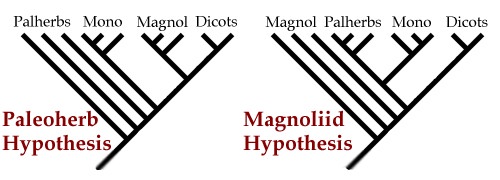







More than one-hundred years ago, Darwin called the origin of angiosperms an "abominable mystery". Angiosperms appear rather suddenly in the fossil record, with no obvious ancestors for a period of about 80 to 90 million years prior to their appearance. Not even fossil leaves or pollen are known from this earlier time.
The truth is that we just don't have many early fossils of angiosperms, and those we do have are troublesome. Many of the early fossils show a mix of features which define modern groups, making them difficult to interpret. The implication, then, is that there was much experimentation in the early evolution of angiosperms, and only later did the features sort out into different lineages.
The rapid diversification of angiosperm taxa began in the Albian, in the mid-Cretaceous, and has continued to this day. At that time, there is an almost exponential increase in angiosperm diversity, and there does not appear to have been any major extinctions of groups in between. Despite the large numbers of taxa that are known from rather early in this diversification, there is no indication of where the taxa are coming from. D.I. Axelrod has suggested that we do not find early angiosperm fossils because the earliest angiosperms lived in dry, upland habitats where the were unlikely to be preserved as fossils. Though this idea has long been accepted, it has not been well investigated and so remains to be tested.
Although there is rapid diversification beginning in the Albian, it is not until the Cenozoic that angiosperms began to take on important ecological roles. Studies of a preserved Maastrichtian (late Cretaceous) landscape from Wyoming suggest that the high diversity of angiosperm species was confined to small populations, and that the vegetation was still largely dominated by ferns and cycads. Angiosperms found at the site were located in ephemeral habitats along streams, and were a minor component of the vegetation (Wing et al. 1993).
This study is welcomed by many paleobotanists as an explanation for the sparse fossil record for angiosperms, but these conclusions will have to await further testing. The site is so far the only one studied, and since it represents only one place and one time, it may not be representative of the global conditions.
Were the first angiosperms trees or herbs?
One of the biggest questions about early angiosperms, besides their origin, is the nature of their growth habit. Were the first angiosperms woody trees and shrubs, or were they small herbs? Each hypothesis has been favored at one time or another, and the question remains unanswered today, though scientific opinion currently favors a woody origin.

Angiosperm Origins: The two competing hypotheses for angiosperm origins paint very different pictures about the biology of the earliest flowering plants. The Paleoherb Hypothesis suggests that the basal lineages were herbs with rapid lifecycles, while the Magnoliid Hypothesis suggests that the basal lineages were small trees with slower lifecycles. ( Dicots=tricolpate dicots; Magnol=magnoliids; Mono=monocots; Palherbs=paleoherbs )
The two hypotheses do not simply differ in their statements about relationships, but paint very different pictures about the implications for angiosperm diversification.
This hypothesis is also favored by molecular studies, and so currently is favored by systematic botanists. It suggests that the earliest angiosperms were understory trees and shrubs, and that the flower was NOT the key innovation for the rapid diversification of angiosperms. In fact woody magnoliids are not particularly diverse, even today.
The implication here is that the key innovations of flowers and a rapid life cycle were present in the earliest angiosperms. It has been suggested that changes in climate or geography provided opportunities for these early angiosperms to diversify.
While the phylogeny for angiosperms presented on our server follows that favored by the Woody Magnoliid Hypothesis, it should be noted that this issue is far from settled. Further evidence and analysis are needed to answer this question.


